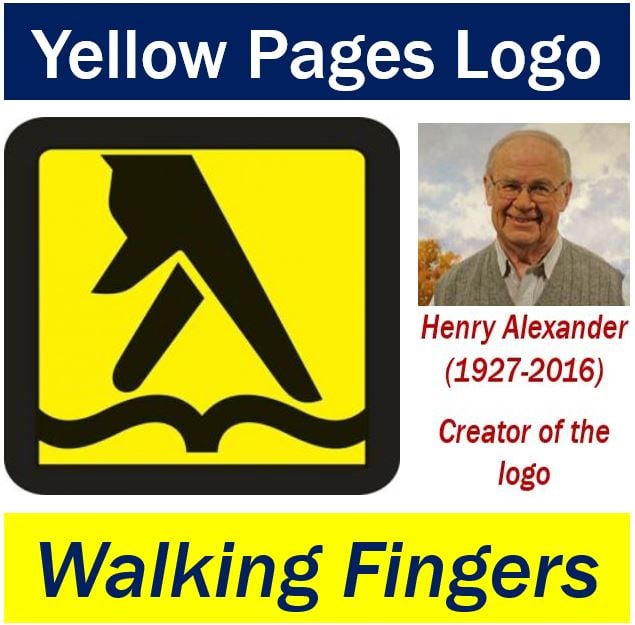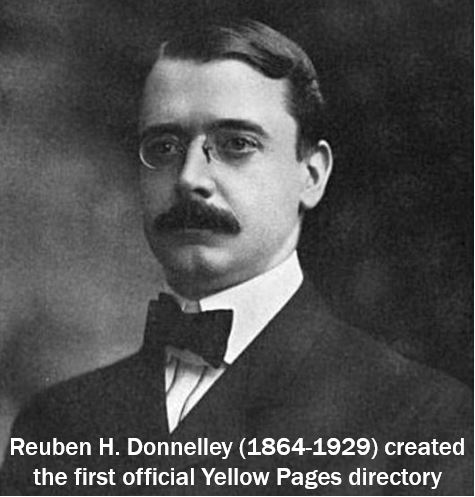The Yellow Pages is a telephone directory of commercial enterprises (businesses), which rather than having entries listed exclusively alphabetically, arranges them according to category (alphabetically within each category). For example, all shoe-shops are listed in one section, auto mechanics in another, law firms in another, etc. Listed businesses can have their details displayed more prominently for a fee, i.e. companies can pay for advertising.
The Yellow Pages, which was printed originally in yellow paper, contrasts with the alphabetically-listed White Pages, which has the telephone numbers of non-commercial entities, i.e. individual people.
In most countries across the globe, the directory of businesses is still printed on yellow paper, while the normal telephone directory of individual people is printed on white paper. The Yellow Pages also exists online.

Yellow Pages – trademark status
In the United States, the name ‘Yellow Pages’ and the ‘Walking Fingers’ logo were never registered as trademarks by AT&T, and can be used freely by publishers.
In many other countries, including the United Kingdom, Canada and Australia, the name and logo are registered trademarks – they were introduced by the Bell System-era AT&T in the 1970s.
In the majority of countries, the Yellow Pages is owned by the main telephone company, or one of its subsidiaries or spinoffs.

Yellow Pages – short history
As soon as Alexander Graham Bell got the first telephone working, its usage spread rapidly. By 1878, enough active telephones existed for a ‘central office’ and an employee to connect and disconnect the callers.
The New Haven Telephone Company in Connecticut – the fastest-growing of the new Bells – published a tiny telephone directory – consisting of one white card with the names of fifty subscribers. The subscribers were divided into four categories:
- Professional.
- Residential.
- Essential services.
- Miscellaneous.
This was the first ever published telephone book.
The first telephone directories only had the subscribers name. They did not include their numbers, because the callers had to connect through the operator.
Reuben H. Donnelley, a printer in Cheyenne, Wyoming, USA, was working on a regular telephone directory when he ran out of white paper. So, he used yellow paper instead. In 1886, Donnelley created the world’s first Yellow Pages directory.
In an article published by Frugal Marketing – A Short History of the Yellow Pages – Mike McDaniel writes:
“It is estimated there are now over 2,300 independent yellow page type directories produced by 250 publishers in the nation; the largest independents are Yellow Book and TransWestern Publishing.”
“In Los Angeles County alone, there are 135 phone books from different publishers and in several languages. The Yellow Pages industry accounts for more than $14 billion in annual advertising sales.”
The term ‘Yellow Pages’ is used globally in English, Spanish, French and most other languages. In some countries, including Romania, the Netherlands, the Republic of Ireland, the Czech Republic, Slovakia and Belgium, the Yellow Pages directory is called the Golden Pages (in the local language).
The directory is published (updated) annually and distributed to all businesses and residences within a coverage area free of charge.
Most of the listings are in small, plain text. The publishers generate profit by selling advertising space. The type of advertising available varies according to publisher and country.

Yellow Pages online
The online business directories are known as YP (Yellow Pages) or IYP (Internet Yellow Pages). In most of the advanced economies, there are two types:
- A consumer-oriented directory.
- A business-oriented directory.
Experian/Hitwise reported in 2011 that ‘Yellow Pages’ was among the fifty most searched for terms in Google, Yahoo and other search engines.
As with the printed version, the online YP is popular for advertisers, because page visitors are high quality leads. For example, law firms are likely to get good responses if they advertise in the ‘law firms’ category of the IYP.
“The Local Search Association released an online search usage study in June 2011. Their study of US consumers on how they find local businesses. 57% had used an Internet yellow pages in the past year. 58% had used a newspaper and 74% used a print phone book and 76% used a search engine.[citation needed] This indicates that buyers use multiple sources to locate a local business.”
hibu
hibu, formerly Yell Group plc, based in Reading, England, is a multinational publisher of business directories. It publishes the Yellow Pages in the UK, the Yellow Book in the USA, and the Paginas Amarillas in Spain.
Globally, the company publishes almost 900 directory editions, distributing more than 200 million copies annually. Its rapidly-growing US unit has 790 editions, while in the UK 111 editions are published.
According to Reference for Business:
“The first telephone directories in the United Kingdom appeared soon after the installation of the country’s first telephone exchanges in London. By the end of 1880, the initial directory counted more than 300 telephone numbers.”
“In the United States, the development of telephone directories led to the creation of the ‘Yellow Pages,’ that is, directories specifically oriented toward providing the telephone numbers and addresses for businesses.”
“As legend has it, the first yellow pages appeared as early as 1886, when a directory printer ran out of white paper and substituted yellow paper instead.”
Video – Yellow Pages
This Canadian video explains how the online directory of businesses – YP – can help commercial enterprises thrive.
